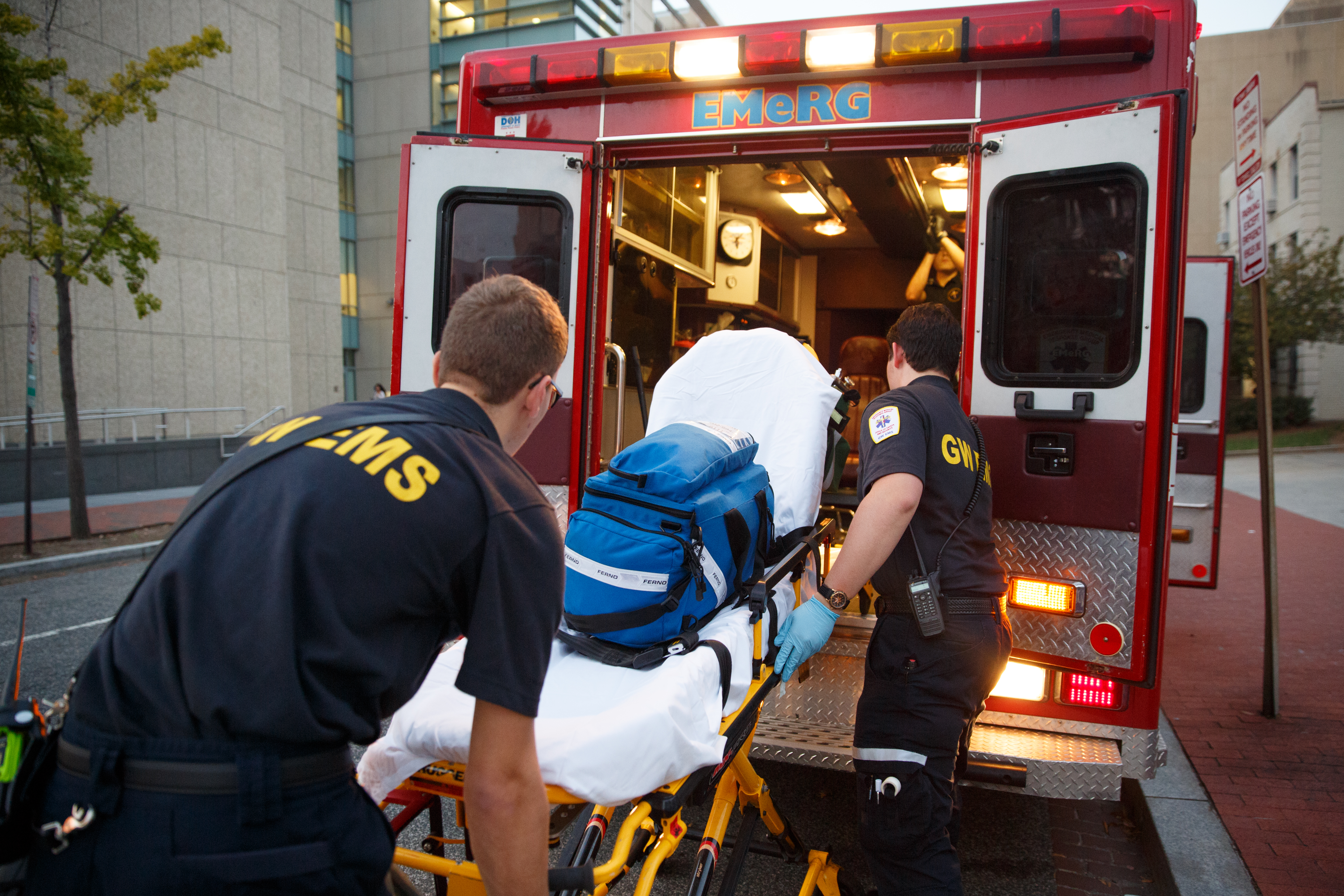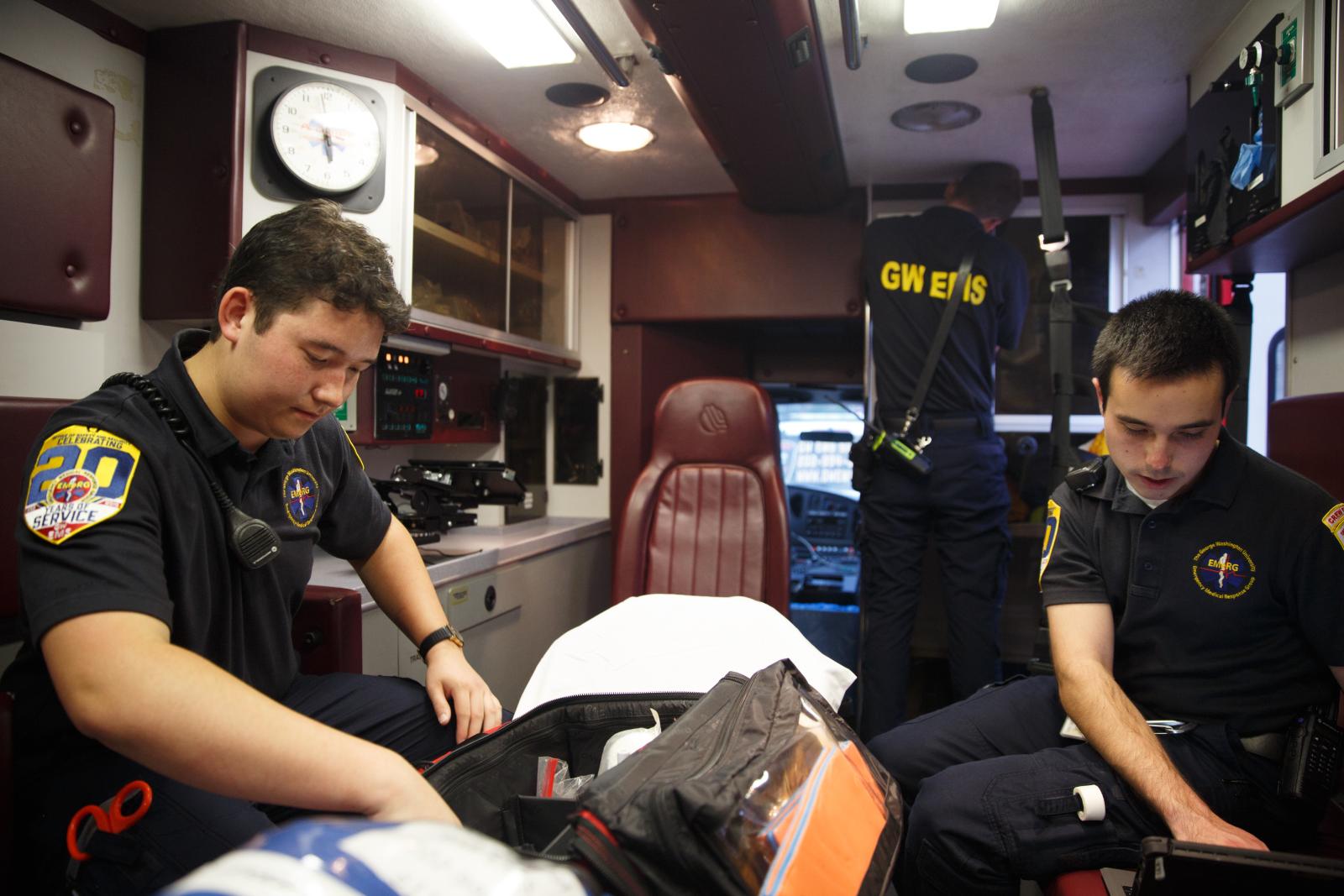By Kristen Mitchell
Sophomore Nate Hammond was hunched over, rummaging through a blue duffle bag, heavy with medical supplies and perched on a stretcher in the back of an ambulance.
Cars whizzed by, visible through the emergency vehicle’s open rear doors. Junior Chris Vakkur ran through an inventory checklist: Bandages in every size? Check. Splints? Check.
Together they combed through every inch of the ambulance’s cab, which was idling at the corner of 22nd and G streets NW. It’s a ritual performed at the start of every shift by members of the George Washington University student-volunteer EMT program EMeRG.
Students walking by craned their necks to get a look inside the ambulance, but the two EMTs didn’t notice. Nebulizers? Check. Infant cannula? Check. When all the medical supplies were accounted for, they wiped down the red cushioned seats, swept the floor and slammed the heavy doors shut.
“So we’ll see if we get any calls tonight,” said Mr. Vakkur, an EMeRG crew chief and international affairs student.
He suspected it might be a slow night. It was an unseasonably warm Thursday evening, but with fall break around the corner, Mr. Vakkur theorized many students already had left campus for the long weekend. He was right. It was six hours before the next call came in for an person needing assistance.
This year EMeRG is celebrating its 20th operating year. The group started with a handful of students interested in EMS work and has grown to a team of 60 volunteers with two ambulances working 24/7 in Foggy Bottom and Fridays and Saturdays on the Mount Vernon Campus.
How far has EMeRG come? Twenty years ago the student volunteers responded to calls on bicycles. Last year, EMeRG worked with the D.C. government to help staff Pope Francis’ visit.
The student EMTs can often respond faster than their counterparts at D.C. Fire and EMS or other local agencies because EMeRG is located in the middle of GW’s Foggy Bottom campus. The group does not charge for their services, and they are licensed to respond throughout Washington, D.C.
While some students find their way to the program as underclassmen, others sought it out long before they arrived on campus. Junior Lili Luevano said that she wanted to be firefighter while growing up in San Francisco.
“I’ve wanted to do that since as long as I can remember,” she said.
Her older sister went to GW, which put the school on her radar. Ultimately the exercise science major was attracted to GW by the established and revered volunteer EMT service. Now Ms. Luevano is president of EMeRG and an ambulance driver who often works well above the minimum 60-hour monthly requirement for her position.
As head of EMeRG, she’s spent countless hours on duty in a tiny office at 2145 G St. NW, outfitted with a large, comfortable couch and bunk beds for volunteers to use on overnight shifts. So far this semester EMeRG has responded to roughly 200 calls, averaging about five a day.
The calls can range from the comical to potentially deadly. There is no way to predict which kind will come next.
This semester EMeRG responded to an older man experiencing cardiac arrest in the Marvin Center. The crew arrived just minutes later. They performed chest compressions on the man and used a defibrillator to restart his heart with electrical therapy. Their efforts restarted his heart. Four days later, the man walked out of the hospital.
Ms. Luevano called the eye-opening incident the highest risk of any to which she had responded.
“I was really proud and amazed by the crew’s ability on that call, especially being in a very visible area in Marvin Center,” she said. “A lot of times our student population is what we see so having an older patient stuck with me.”
EMeRG members all have a basic EMT certification and respond primarily to basic medical needs like routine falls on campus and transporting patients from the Colonial Health Center who need to go to the hospital. D.C. Fire will typically respond to high acuity calls, and EMeRG members can radio them to respond when advanced care is required.
Senior Andrew Sanborn said he signed up to become EMT certified as a sophomore in the Elliott School of International Affairs when he needed to add a few more credit hours to his schedule.
“It just completely changed the direction of my college experience and that made me interested in public health,” he said.
His experience in the class led him to join EMeRG and focus his studies on public health within ESIA. Now he’s a field training officer and crew chief, a position that comes with 80 mandatory hours of work a month. Mr. Sanborn said helping the community and spending time with the other students in the program make the taxing time commitment worth it.
EMS Coordinator and EMeRG alumnus Kevin Sullivan said whether students come to GW looking for the program or sign up on a whim, it becomes a lifestyle for volunteers.
“They eat, sleep and breathe EMeRG,” he said.
The crew is currently preparing for the Presidential Inauguration on Jan. 20 when they will provide on-site medical support as thousands of people flock to the Capitol grounds and the National Mall for the festivities. EMeRG alumni also will return to campus for a celebration and dinner during Alumni Weekend to mark the 20-year anniversary of the program.
EMeRG responds to about 1,000 calls a year, Mr. Sullivan said. He estimates EMeRG saves patients between $250,000 to $500,000 a year because the service is free.
One common misconception people have about the program is that they spend a lot of time dealing with intoxicated patients. Mr. Sullivan said assisting intoxicated patients makes up about 17 percent of the agency’s calls—less than the 19 percent of calls for traumatic injuries.
“We run the gamut of calls, from stubbed toes to cardiac arrests,” he said.
Every once in a while an unforgettable case comes along, like the time GW senior and crew chief Jacob Burman responded to a student with a gum wrapper stuck deep in his ear canal. He needed to go to the emergency room.
“I guess he had an itch in his ear and so he tried to use a gum wrapper to scratch that itch, and it ended up getting really far in his ear to the point where they couldn’t see it anymore,” Mr. Burman said. “We’re not surgeons. We’re not going to be digging around inside someone’s body to take something out that’s in there that shouldn’t be.”
EMeRG transported the student to the emergency room.
Mr. Burman said when someone is having what could be the worst day of his life, helping in any way is a powerful experience and responsibility.
“It’s definitely changed my trajectory in my college career and where my life was going,” he said. “I couldn’t have been happier to be doing it.”













